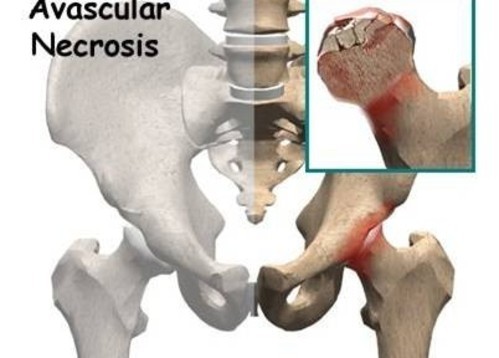
Avascular necrosis
 Avascular necrosis is the death of bone tissue due to a lack of blood supply. Also called osteonecrosis, avascular necrosis can lead to tiny breaks in the bone and the bone’s eventual collapse.
Avascular necrosis is the death of bone tissue due to a lack of blood supply. Also called osteonecrosis, avascular necrosis can lead to tiny breaks in the bone and the bone’s eventual collapse.
The blood flow to a section of bone can be interrupted if the bone is fractured or the joint becomes dislocated. Avascular necrosis of bone is also associated with long-term use of high-dose steroid medications and excessive alcohol intake.
The hip is the joint most commonly affected by avascular necrosis. While avascular necrosis of bone can happen to anyone, it usually occurs in men between the ages of 30 and 60.
Symptoms
Many people have no symptoms in the early stages of avascular necrosis. As the condition worsens, your affected joint might hurt only when you put weight on it. Eventually, you might feel the pain even when you’re lying down.
Pain can be mild or severe and usually develops gradually. Pain associated with avascular necrosis of the hip might center on the groin, thigh or buttock. Besides the hip, the areas likely to be affected are the shoulder, knee, hand and foot.
Some people develop avascular necrosis on both sides (bilaterally) — such as in both hips or in both knees.
Causes
Avascular necrosis occurs when blood flow to a bone is interrupted or reduced. Reduced blood supply can be caused by:
- Joint or bone trauma.An injury, such as a dislocated joint, might damage nearby blood vessels. Cancer treatments involving radiation also can weaken bone and harm blood vessels.
- Fatty deposits in blood vessels.The fat (lipids) can block small blood vessels, reducing the blood flow that feeds bones.
- Certain diseases.Medical conditions, such as sickle cell anemia and Gaucher’s disease, also can cause diminished blood flow to bone.
For about 25 percent of people with avascular necrosis, the cause of interrupted blood flow is unknown.
Complications
Untreated, avascular necrosis worsens with time. Eventually, the bone can collapse. Avascular necrosis also causes bone to lose its smooth shape, potentially leading to severe arthritis.
Avascular Necrosis Treatment
Treatment goals for AVN are to improve the joint, stop the bone damage, and ease pain. The best treatment will depend on a number of things, like:
- Your age
- Stage of the disease
- Location and amount of bone damage
- Cause of AVN
At Alimran Medical Center, we may recommend any of the following treatments
Regenerative medicine treatment (Prolotherapy)
Steroid injection
- Electrical stimulation
- Short and long wave
- Laser therapy
- Ultrasonic therapy
- Magnatic therapy
- Exercises
